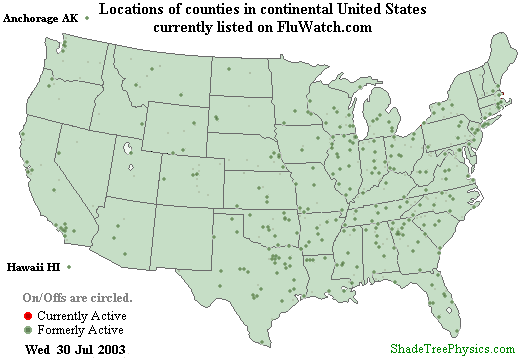USA Influenza Activity 2002-2003, Part 1
The map above shows red dots placed at the approximate centers of counties listed as active on FluWatch.com. For large counties, the dots are placed according to their zip code locations as determined from MapQuest.com®. Display of the FluWatch.com active areas does not imply that influenza is absent in other places. For examples, here is a limited list of links to flu information for individual states and countries.
Canada - Illinois - Missouri - U.S.A. CDC - West Virginia
Below is a seasonal histogram of U.S. Fluwatch activity levels as defined in the next paragraph.
The ZymeTx, Inc. rapid throat swab test, used as a basis for FluWatch reports, checks for influenza A and B, but does not differentiate them. FluWatch uses the following levels of flu activity in a given area. Watch: Positive flu results have been reported. Alert: Positive flu results are being reported as consistently as every other day in moderate numbers. Warning: Positive flu results are being reported consistently on a daily basis in high numbers. Epidemic: Flu is widespread in the area.
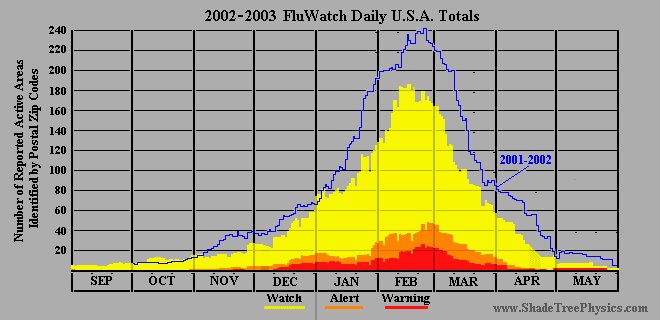
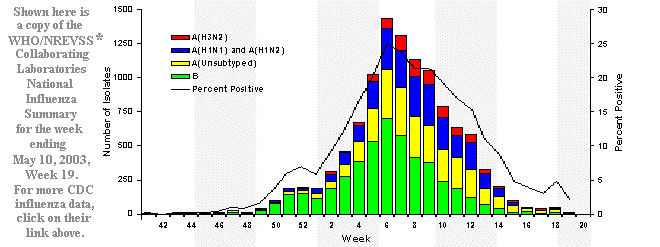
*U.S. World Health Organization and National Respiratory and Enteric Virus Surveillance System.
Please see the corresponding graph for North Dakota.
US Influenza Summer 2002
State Summaries for 2000-2001, 2001-2002, and 2002-2003.
USA Influenza Activity 2002-2003, Part 2
(Including SARS Information)
Part 2 was extracted from the original webpage (Now Part 1) on 24 March 2003.
First time visitors to Part 2 may want to
review the following articles before proceeding.
Influenza From Space?
Life on Venus?
* * *
The following table shows: (I) the dates of Venus inferior conjunctions
which preceded 20th century influenza Pandemics and Pandemic Scares (P&PS),
(II) onset dates for the disease outbreaks and (III) the intervals (in days)
between conjunctions and event onsets. These intervals are converted to
decimal fractions of the 584 day Earth-Venus synodic period and are
displayed in the histogram on the right, in which the width of each bin is 1/20th of
the synodic period (29.2 days per bin). The 1988 limited outbreaks of Influenza
A(H1N2), in China, and the 2001 Global outbreak of Influenza A(H1N2) have been
added. In 2001 the earliest published identification of A(H1N2) of which this
writer is aware, was in Texas in July. See: Sunspot Activity, Venus Inferior
Conjunctions, and Biological Events for further information on the 20th century
events.]
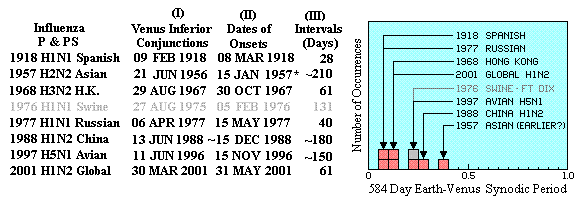
*Some scholars report that the 1957 Asian flu was "making the rounds" in Vladivostok in December of 1956. Its earliest outbreak date and location are currently unknown to this writer.
Notes
It is now known that the 2001 initial outbreak of Influenza A(H1N2) occurred in India on 31 May. That was 61 days following the 30 March Venus inferior conjunction, instead of the 110 days as previously shown). The table and graphs have been modified to show this change. [Added 10 Jan 2008. Updated 28 Jan 2009.]
For comparison, here is a graph of the influenza outbreaks by calendar date.
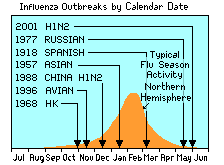
Special Flu Advisory - 6 November 2002
See Influenza 1918, A Venus Connection? for the rationale behind this advisory.
Flu Season News 2002-2003
(This section has evolved into mostly SARS news.)
Saturday 14 December 2002
The Associated Press - Little Rock Arkansas. "Illness sends students home in droves, shuts down
district. - Arkansas health officials look into flu-like sickness. - Illness broke out among football
players and band members in the Junction City School District last week." [Junction City is in Union
County which is on the southern border (mid-state) of Arkansas.]
"School superintendent Kelly was quoted as assuming the illness was flu, but stressed "that his
assumption has never been confirmed." ..."I've closed down for a lot of things but never flu,"
Kelly added. ..."All week, students complaining of fever, headaches and stomach pain have stayed
home or sent home in high numbers."
[Schools in Columbia County, just west of Union County, were also reported to have been hard hit.]
Source The Commercial Appeal, December 4, 2002, Memphis, TN, Page A16.
[ In a telephonic interview on 7 April 2003, Superintendent Kelly said that the illness that shut his school down was never confirmed to be influenza. He said that Junction City played a home game on 25 November against Hector Arkansas, and that a number of the Hector team members were displaying flu-like symptoms during the game. Some Junction City football players became ill by 2-3 December. That timing suggests a 7-8 day incubation period, if 25 November was when the Junction City football team and band were exposed to their "bug." (Hector is in the central Northwest part of Arkansas.)]
16 February 2003
Mystery bug causes panic across China - The Observer International -
"[U]nidentifed bug appeared in November: five have died."
(Thanks to Eric Fritzius of West Virginia for the link.)
17 February 2003
According to the 14 February 2003 Guardian Newspapers article,
China in a Panic over Mystery Bug, the pneumonia-like illness, described by the
World Health Organization as an "acute respiratory syndrome," broke out in
mid November 2002.
7 March 2003 - Associated Press
http://www.sierratimes.com/03/03/07/arpubap030703.htm
"Connecticut Quarantines 4.7 Million Chickens to probe disease outbreak -
[P]articular strain suspected is considered a low-grade pathogen. " [Article mentions
recent "low-risk" avian influenza in Pennsylvania that turned deadly.
Initial outbreak dates to be determined. See the 18 April Netherlands
Avian Influenza entry.] [Link no longer functional. Removed 25 Jan 2005.]
15 march 2003
Drudge Report has four Killer Pneumonia links today. Stories are apparently
related to the 17 February 2003 China Mystery Bug entry above.
The links are as follow.
http://reuters.com/newsArticle.jhtml?type=topNews&storyID=2385604 UN Warns of WorldWide Threat from Killer Pneumonia - Reuters - [Non-functioning link removed 25 Jan 2005.]
http://cnews.canoe.ca/CNEWS/Canada/2003/03/15/43929-cp.html Severe pneumonia hits Canada - Cnews Canada - (CP) [Non-functioning link removed 25 May 2011.]
http://www.washingtonpost.com/wp-dyn/articles/A30294-2003Mar15.html U.S. Monitoring Deadly Pneumonia Outbreak in Asia - Washington Post - Reuters - [Non-functioning link removed 25 Jan 2005. ]
http://www.newsday.com/news/local/wire/ny-bc-ny--us-pneumonia0315mar15,0,5125768.story?coll=ny-ap-regional-wire NYC hospitals on alert for mysterious pneumonia striking Asia - Newsday.com - AP
[Non-functioning link removed 25 Jan 2005.]
(Thanks to Eric Fritzius of Lewisburg, West Virginia, for the news tip.)
18 March 2003
http://news.yahoo.com/news?tmpl=story2&cid=564&u=/nm/20030319/ts_nm/health_pneumonia_dc_28&printer=1 [KaZang!] Doctors in Hong Kong Identify Killer Virus - Yahoo! News - Reuters story reports Hong Kong pneumonia virus belongs to the paramyxoviridae family. WHO is seeking to see if the Hong Kong pneumonia is related to respiratory diseases in southern China. Suspected cases have also been identified in Australia, Britain, Spain, and the United States.
18 March 2003
Hunt for SARS agent intensifies -
The Scientist Daily News - In association with BioMed Central. "The National Microbiological Laboratory (NML) in Winnepeg (sic) Canada has looked for more than 250 known causes of lung infection
in samples from Canadian patients with SARS (Severe Acute Respiratory Syndrome) ..." Whatever this is,
it smacks of something brand new -- a new cause of pneumonia,"
22 March 2003
Global alert over pneumonia - TheIndianEXPRESS - World Health Organization has issued
an emergency global alert regarding the pneumonia-like illness. At least 300 cases have been found outside
China.
23 March 2003
Mystery pneumonia identified - theage.com.au - A Hong Kong team of virologists has
isolated the new virus believed to be the cause of the Severe Acute Respiratory Syndrome
(SARS). Work is underway to determine the relation between the new virus and known
viruses.
Thursday, 03 April 2003 - [Counterpoint]
SARS (Severe Acute Respiratory Syndrome):
A Great Global SCAM - Leonard G. Horowitz, D.M.D., M.A., M.P.H., argues that
SARS is an ingenious social experiment featuring institutionalized bioterrorism for widespread
psycho-social control.
Tuesday 8 April 2003
Strong evidence has been found by Hong Kong researchers that the virus responsible for Severe Acute
Respiratory Syndrome (SARS) has not been previously identified in human beings or animals.
Source: The Lancet, Saturday 5 April, 2003, Volume 361, Number 9364, published
online.
Friday 11 April 2003
http://www.biomedicalcentral.com/news/20030411/04Cause of SARS disputed -
Head of Canadian lab investigating SARS is not convinced that coronavirus causes SARS. ...
'The proportion of our samples [from Canadian SARS patients] that show the corona virus is
going down." [Added to page on 29 May 2003.] [Link deleted 25 Jan 2005.]
Source: TheScientist Daily News - in association with BioMed Central.
Tuesday, 15 April 2003
Scientists Crack SARS Genetic Sequence - National Geographic News - "This past
weekend, researchers from the Michael Smith Genome Sciences Centre in Vancouver Canada,
became the first to complete the DNA sequencing of the deadly virus." . . ."Although the SARS
virus shares its structure with other coronaviruses, the proteins that make up its content are
completely different, making it a brand new virus." . . ." 'We don't see any recombination,' said
Rob Holt, head of the Genome Sciences Centre."
[Article found with Google™ News. Search words:
SARS sequencing Canada.]
Friday, 18 April 2003
AVIAN INFLUENZA - NETHERLANDS (21) PIG INVOLVEMENT
"Excerpts from Letter VVA03.1238GM of 15 Apr 2003 from the
Minister of Agriculture to the Speaker of the Dutch Parliament
[translated from Dutch by Mod.AS, edited]
http://www.minlnv.nl/infomart/parlemnt/2003/par03124.htm [Link removed
25 Jan 2005.]
1. In my letter of 19 Mar 2003 I indicated that antibodies against
Low-Pathogenic Avian Influenza [LPAI] were detected in Dinteloord.
. . . This involved samples collected in 2002 and kept frozen in the
Faculty of Veterinary Medicine in Utrecht. Virus isolation trials have
demonstrated that the relevant virus was a low-pathogenic variant, confirming
the presence in the Netherlands at the end of 2002 of an H7 LPAI virus.
. . .
Presumably, the virus mutated to become a highly pathogenic
variant and caused the outbreak on 28 Feb 2003."
Source: ProMED Digest V2003 #148
Saturday, 19 April 2003
AVIAN INFLUENZA, HUMAN - NETHERLANDS (09): FATAL CASE
-
"A 57-year old veterinarian who visited a poultry farm affected by HPAI H7N7
infection (in Teefelen) died on 17 April 2003, as the result of acute respiratory
distress syndrome (ARDS) and related complications in a hospital in
's Hertogenbosch [Den Bosch], The Netherlands. . . . [Patient was diagnosed
with bilateral pneumonia.] . . . Since the beginning of the HPAI H7N7 outbreak
in chickens in The Netherlands at the end of February 2003, 82 confirmed
cases of human H7N7 influenza viruses have been recorded."
Source: ProMED Digest V2003 #150
Wednesday 23 April 2003
Southern Vietnam childhood death toll rises to 19 - "At least 7 more children have
died from an unknown virus in Ho Chi Minh [City] and other places in southern Vietnam,
bringing to 19 the number of children who have died from this disease since
February 2003. . . . Symptoms were high fever and diarrhea, aggravated by
respiratory and cardiac problems. Enterovirus infection is suspected...
Health authorities discounted the idea that these cases could be related to
SARS..."
...
"Sarawak [Malaysia]* has been experiencing a large outbreak of human enterovirus 71
that began in February 2003. Most cases have uncomplicated hand, foot and mouth
disease, but a small number include neurological disease. Phylogenetic analysis of recent
isolates of human enterovirus 71 by Jane Cardosa and colleagues in Sarawak indicate that
several genogroups of the virus have been circulating in the Asia-Pacific region since 1997."
*[Sarawak is on the Northwest coast of Borneo and is roughly 750 miles SSE across the
South China Sea from Ho Chi Minh City.]
Source: ProMED Digest V2003 #163.
Sunday 27 April 2003
Vietnam: childhood death toll doubles to reach 38 -
"A still unidentified sickness has killed 38
children and left more than 60 others ill in 17 Vietnamese provinces in the
past three months, ... Officials said it did not appear to be _Human
enterovirus 71_, which killed 30 in Malaysia in 1977 and more than 50
children in Taiwan in 1998 [and is currently responsible for an extensive
outbreak in Sarawak. - Mod. CP]".
"Doctors and medical experts, along with the World Health Organization (WHO),
completed an epidemiology survey in Ho Chi Minh City on 15 April 2003. They
did not classify the illness as an outbreak because the cases did not appear
to be linked and were scattered throughout many provinces, the Newspaper said.
All the children who succumbed to the disease experienced high fever and
convulsion. Nearly 70 per cent of them died within a day of becoming sick."
Source: ProMED Digest V2003#165
[The widespread (non linked) nature of this disease is suggestive of an atmospheric (aerobiological) delivery mechanism. Was there a regional rain storm that covered all 17 affected Vietnamese provinces a few days prior to the initial cases? RSF]
Thursday 01 May 2003
12 SARS Patients Report Relapses
------------------------------
"Local health officials said [in Hong Kong] tonight that a dozen patients who
had seemed to recover from SARS became ill again after leaving the Hospital."
In some cases, the illness returned more than two weeks after discharge, according
to a medical expert here who refused to be quoted by name. It is not clear whether
the patients contracted the infection a second time, or simply became ill with the
same virus after seeming to recover."
...
"The World Health Organization said today that it had not yet received reports
of relapses. Dr. Mark Salter, a medical officer with the agency, said it was
monitoring the nearly 2500 SARS patients worldwide who have been discharged
from hospitals and had seen no reports of relapses or recurrences."
...
"None of the relapses or recurrences in Hong Kong have occurred among
SARS patients hospitalized in the first wave of infections, when doctors tended
to delay prescribing steroids until a patient's pneumonia worsened. The delay
might have allowed enough time for a patient's immune system to begin fighting
off the SARS virus before steroids began suppressing the immune defenses."
...
[Byline: Keith Bradsher with Lawrence K. Altman]
Source: Pro-MED Digest V2003 #174
Friday May 2, 2003
USA: Minnesota Reports First West Nile Virus-positive Equine in 2003
- --------------------------------------------------------------
'A mare near Brainerd has tested positive for West Nile Virus, the nation's
first case in a horse this year. Minnesota veterinarians and health officials
had expected the mosquito-borne disease, which humans can contract, to
emerge in late June or July, but it hit nearly 2 months early. "This is an
extremely unusual event," said David Neitzel, a state Health Department
Scientist specializing in mosquito-borne diseases.'
Source: Minneapolis Star Tribune, Fri 2 May 2003 [edited]
Copied from ProMED Digest V2003 #176
[See the 20 February 2003 entry above for West Nile Virus activity reported in humans in Chicago, IL during January and February 2003. RSF]
Sunday May 4, 2003
http://www.msnbc.com/news/909018.asp?vts=050420031800
[Link removed 25 Jan 2005.]
SARS can live on common surfaces [Article contains information on
survivability of the SARS virus and on its alternate modes of transmission.]
Source: WashingtonPost.com Highlights - MSNBC
Thursday 8 May 2003
New illness Raises Alarm in Cambodia
BORGHOCK, Cambodia - In a remote Cambodian hamlet, a tribal chief
chanted prayers, to fight a mystery illness - with symptoms similar to SARS - -
that was sweeping his community. After weeks of investigations, Western and
Cambodian doctors have ruled out severe acute respiratory syndrome. But the
unknown disease has killed 7 of the 393 people infected in the villages of Borghok
and Ping in northeastern Cambodia.
. . .
Doctors visiting Borghok and Ping said the disease was like nothing they had
seen before. The symptoms included fever, coughing, breathing problems - - all
signs of SARS, But the victims also suffered from diarrhea and maintained normal
white blood cell counts, something not usually found in SARS patients.
...
The outbreak began on 2 Mar 2003, ...
...
When it appeared that patients responded to antibiotics, health officials felt
confident enough to rule out SARS.
Source: The State.com (SA) 8 May 2003 - An edited version was reprinted in
ProMED Digest V2003 #185 [The ProMED article says that the disease
appears to have died out in late March 2003. (Confirmation pending.) RSF]
Thursday 8 May 2003
The SARS Virus is Mutating in Response to Immunulogical Pressure
------------------------------------------------------------------------------------
NEW YORK: After sequencing the genomes of 14 isolates of the severe
acute respiratory syndrome coronavirus obtained from five cities, scientists
in Singapore found evidence that immunological pressures may already be
influencing the evolution of the virus. Their early-release report will be
published on Fri 9 May 2003 on the Lancet journal website.
www.thelancet.com
...
Furthermore, coronaviruses "ominously" resemble influenza A viruses, in
that both "are zoonoses [diseases that can spread from animals to man], both have
instances of dual tropism [two modes of reaction by an organism to a stimulus] for
respiratory and gastrointestinal tissues, and most importantly, both possess
mechanisms for the generation of extreme genetic variability."
Source: ProMED Digest V2003 #187.
[A second report in issue #187 suggests that the genetic variations seen in the SARS viruses is "limited" and may result from adaptations to laboratory conditions. On the other hand it suggests that that the human immune system is not being very effective at producing defenses to SARS. - The ProMED moderator advises caution with regard to premature speculation from a limited data set. RSF]
Friday 9 May 2003
Bird Flu Case Suspected at German Farm
BERLIN: A farm near Germany's border with the Netherlands was sealed off
Friday and 32,000 chickens were ordered slaughtered after a suspected case
of bird flu was reported.
...
The outbreak in the Netherlands is believed to have been caused by
contact between wild ducks and farm poultry.
Source: ProMED Digest V2003 #187
Saturday 17 May 2003
Note to readers. - The first reported cases of what is now known as
SARS (Severe Acute Respiratory Syndrome) occurred on 16 November 2002. That date
was one day after the 15 November earliest date for outbreaks of new
flu-like illnesses, as predicted on this website in early November. (See the Special Flu Advisory -
6 November 2002, above.) It will be instructive to determine the details of the initial
outbreak of SARS. Did it start with a single person, who then passed it on to others, or
did people in different locales come down with it more or less at the same time? If multiple
(short-time-frame) infections occurred, what was the geographical size of the epicenter?
If more than one epicenter, how many were there, and where? This line of questions touches
on the claim by Sir Fred Hoyle and Chandra Wickramasinghe that "[I]nfluenza outbreaks are
often caused by newly arriving viruses from space."
See: Influenza From Space?
at Brig Klyce's Cosmic Ancestry
website..
Sunday 18 May 2003
Situation in Singapore
-------------------
The ministry of Health in Singapore has today determined that the cluster of
patients and staff in the Institute of Mental Health who developed fever on 11
to 12 May 2003 does not represent cases of SARS. None of the patients, including
34 inpatients and 20 staff at the Institute, has shown any signs of clinical
progression characteristics of SARS. Alternative diagnoses, including influenza
and other causes of upper respiratory tract infection, have further excluded
suspicion of SARS. Of the 54 patients, 25 have been discharged, and only 7
continue to have mild febrile illness. [More]
Source: ProMED Digest V2003 #201
Friday 23 May 2003
Exotic market animals likely source of SARS
Three exotic animal species in China (including weasel-like civet cats) have been found
to be
possible sources of SARS. . . ."Genomic analysis suggests that these animal isolates are
precursors to human isolates." - Source: NewScientist.com
Friday 23 May 2003
In reference to a Yahoo News article titled "WHO Traces SARS Virus to
Civet Cat," SARS moderators in ProMED Digest V2003 #209 say: "[(stuff deleted)...
just because an animal tests positive does not mean anything other than exposure to the
virus, there is still no evidence it originated with animals. - Mod.TG/JW]"
Friday 23 May 2003
Is SARS from outer space? - Professor Chandra Wickramasinghe of Cardiff University
suggests to Lancet that SARS was introduced to Earth on a comet or meteorite. -
Source: CNN.com/science & Space - (Thanks to Dean Priest of Columbus, MS for the Link.)
[The thesis underlying this Shade Tree Physics page is that Venus is the biggest comet around. RSF.]
See the basic article.
Tuesday 27 May 2003
Human SARS virus not identical to civet virus - With one exception (out
of 60 sequences of human SARS) the human virus had 29 fewer nucleotides in
the N-protein. (The function of the N-protein is unknown.) . . . Research is
hampered by a lack of a unified global SARS sequence database! . . ."The
epidemiological evidence would not suggest that these animals play a role
[in human SARS], but we want to play safe." [In April, some Canadian
researchers reported doubts that the coronavirus was actually the causative
(causitive) agent of SARS. See the 11 April 2003 entry above.]
Source: www.the-scientist.com Daily News - in association with
BioMed Central.
Wednesday 28 May 2003
Unexplained Deaths in Tanzania - Officials from Tanzania's ministries of Health and Water and
Livestock Development will soon meet to try to identify the cause of a mysterious disease that has
killed 55 youths on Ukerewe island, Lake Victoria.
Acting Chief Medical Officer in the Ministry of Health...would not give the data of the death toll by last week, but admitted that the situation was "serious," with some 582 people already infected by the viral disease that seems to affect mainly youths in the interior of the island.
A Deputy Minister, in the Ministry of Water and Livestock Development, said that there is enough
scientific evidence that the mysterious disease was not caused by [chemicals in drinking] water,
[poisoned fish were ruled out too] adding that there was a need for a multidisciplinary approach to
understand the cause of the disease. - First case was reported in May 2002.
Source: ProMed Digest V2003 #218
[There was a end-of-season "surge" in U.S.A. influenza activity (reported by FluWatch.com) in May of 2002, followed by what might have been an "aftershock" in July (maybe no connection). See USA Influenza Activity Summer 2002. North Dakota had a very unusual end of season peak in influenza activity in early May 2002. See the 2001-2002 and 2002-2003 North Dakota Influenza Activity graph. South Dakota had a less pronounced peak of Influenza B at the approximate same time.]
Friday 30 May 2003
Wheat Streak Mosaic - Australia - Wheat streak mosaic virus (WSMV) is being found on roadsides. Spread continues. - As farmers continue planting the winter wheat crop, they're being told a previously unseen
virus is actually widespread in at least two states. [South Australia and Victoria] The virus may
have been in Australia for decades. ... Moreover, it appears that 2 different WSMV strains are present
here, which is interesting because there is only 1 strain througout the USA. [Emphasis added. RSF]
Source: Australian Broadcasting Corp., Rural News Online, 26 May 2003 - Courtesy - ProMED Digest V2003 #220.
[If it turns out that WSMV fares better in a CO2 rich environment, then the Australian roadside findings may be related to exhaust emissions from highway traffic. RSF 31 may 2003]
Friday 30 May 2003
Hantaviurs Infections - Brazil
Three new cases of hantavirus infections are reported, including one death. Three Brazilian states
(Minas Gerais, Santa Catarina, and Sao Paulo) have ongoing hantavirus problems.
According to a ProMED Digest moderator, the 23 May 2003 Sao Paulo fatality, was a Chinese man
who was initially thought to have symptoms compatible with SARS. However, it was established
subsequently that he had not been in China for 5 months.
Source: ProMED Digest V2003 #222 - (Translated from Brazilian news sources.)
[Five months prior to 23 May 2003 would have been December 2002. December was in this writer's 45 day lookout window for strange new diseases. A SARS connection may not be out of the question. - RSF 1 June 2003]
Thursday 9 Oct 2003
Hemorrhagic Fever With Renal Syndrome - France (NE)
In total 104 cases of hantavirus infection [i.e. resulting in hemorrhagic fever with renal syndrome or
HFRS, the type of illness associated with hantavirus infection in Northern Europe] have been reported
by the Centre National de Reference (CNR) de Fievres Hemorragiques Virales (the National Reference
Centre for Viral Hemorrhagic Fevers) during the period from the end of December 2002 to the end of
August 2003.
This number is higher than the number of cases for the preceding 3 years; during the whole of 2002 only 61 cases of infection were observed. ...
All the cases were presumed to have been infected close to their homes. The dates of onset of signs of
illness were known for 43 of the 54 cases investigated. Most (29 percent) exhibited initial signs of infection
during January and February [2003], and to a lesser extent in early spring 2003. ... The majority of the
patients reported exposure to risk factors during the 2 weeks preceding the onset of illness. 63 percent
of the patients lived in forested areas, 9 (17 percent) were hunters, and 3 (6 percent) had contact with
rodent carcasses; and almost all the others had some professional, recreational, or other involvement
with forest products or woodland areas.
Source: ProMED Digest Thursday, October 9, 2003
Volume 2003 : Number 401
[Hantaviruses that cause {Hantavirus Pulmonary Syndrome} HPS are carried by rodents, especially the deer mouse. You can become infected by exposure to their droppings, and the first signs of sickness (especially fever and muscle aches) appear 1 to 5 weeks later, followed by shortness of breath and coughing. Once this phase begins, the disease progresses rapidly, necessitating hospitalization and often ventilation within 24 hours. CDC]
[Hanta virus infections are associated with domestic, occupational, or recreational activities that bring
humans into contact with infected rodents, usually in rural settings. Known hantavirus infections of humans
occur primarily in adults. HPS cases in the United States occur througout the year, but greater numbers are
reported in spring and summer.
CDC]
Sat 18 Oct 2003
Re: China Orthoreovirus Co-infection in SARS patients
On Fri 17 Oct 2003, Dr. Steve Berger drew attention to a recently-published
finding that 1.2 to 2.9 percent of healthy individuals tested in Guangdong
were seropositive for SARS-associated coronavirus. . . .
A study published in China in July 2003 may be of interest in light of this
apparent anomaly. The study, conducted by the Academy of Military Medical
Sciences (AMMS), states that while the SARS coronavirus "has been
confirmed" as the cause of SARS, the presence of reovirus in 24 of 38 serum
samples taken from SARS patients, and only 1 of 35 subjects in a healthy
control group, suggests the possibility of co-infection. The authors
conclude, with due caution, that SARS could be a combination of the [SARS]
coronavirus and [a] reovirus.
. . .
Source: ProMED Digest Sunday, October 19, 2003
Volume 2003 : Number 410
21 October 2004
Avian flu infected 1,000 people in 2003, Dutch report says
Oct 20, 2004 (CIDRAP News) Avian influenza probably infected at least 1,000 people during a
major outbreak in the Netherlands in 2003, many more thatn originally thought, Dutch researchers
say. . . .
The outbreak among poultry began in late February of 2003 in the province of Gelderland and spread to 255 farms. About 30 million chickens, or 28% of chickens in the Netherlands, died or were killed to control the disease. At the time of the outbreak, 83 people were confirmed to have the H7N7 virus, and one veterinarian died. Poultry cullers and veterinarians had the highest attack rates, the RIVM* report says.
Full story is at
CIDRAP News Center for Infectious Disease Research and Policy, University of Minnesota
RIVM: Rijksinstituut voor Volksgezondheid en Milieu
Thanks to: Flu in China (FIC) News Center.
Recommended Web Pages.
Neuramidase In SARS? - None Known in Any Coronavirus - Robert E. Lee finds evidence suggestive of a "not like any known" neuramidase in the SARS virus.
Severe Acute Respiratory Syndrome (SARS) - World Health Organization - Communicable Disease Surveillance & Response (CSR)
Hail Venus! Is There Life Here? Popular Science, February 2003. "A small group of scientists have their heads in the hot clouds of the 2nd planet."
Hidden piece of influenza virus protein found - Sci Tech - The Hindi - Online edition of India's National Newspaper, Thursday, Dec 13, 2001.
Home | Up one level | Prev | Next
Top
